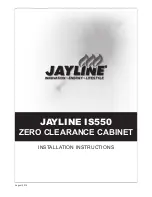
Revised: 14/11/2011
Printed: 20/03/2013
5
Reloading
The firebox should be loaded to a minimum of 2/3 full, preferably when the fuel has burnt down to a
bed of coals. Attempting to reload part way through a burn period risks smoke, coals, or a log rolling
from the heater. Before reloading, it is important to position the air inlet control to high. Taking care,
open the door slowly, rake over the coals and load the fuel as recommended. After reloading, close
the door securely and leave the air inlet fully open on high until the fuel load is well alight. Then the
inlet control can be adjusted to your desired heat output.
Do not throw wood into the firebox
This is an unsafe practice and may dislodge the baffle plate in the heater. It may also cause sparking
or dislodge burning wood, which could ignite any combustible materials in the area surrounding the
heater (eg. Carpet).
Do not slam the door closed
Wood may be protruding from the firebox and cause the glass to break. It will also diminish the
longevity of the door seal.
Preparing for a low (overnight) burn
For an extended low burn, following the reloading procedure outlined previously, ensuring a maximum
fuel load is placed into the heater. Remember, the greater the fuel load, the longer the burn. After
reloading, close the door and leave the air inlet fully open (high) until the load is alight. The air inlet
should then be turned down to a *lower setting. *The optimum low setting may vary for different
reasons, experiment to find the best result!
Self cleaning through high firing
It is perfectly normal for the glass door to experience some blackening after extended periods of low
burning. High firing helps burn the door glass clean and minimise soot, carbon and creosote formation
on the baffle plate and flue as well. High firing can be done daily during the heating season and
morning is usually the best time.
Just start or rebuild the fire with the firebox at least 2/3 full, set the air inlet control to high and let the
heater operate in this manner for at least 90 minutes.
Note: Ensure that the heater fan is switched to high during this procedure, failure to do so may result in
excessive deflection of the heater top panel, or damage to the fan / wiring.
Paint curing
To prevent discolouration of the high temperature paint, do not burn a large fire until the paint on the
heater has cured, i.e. Do not operate with the air inlet control positioned any higher than mid-point for
approximately the first 12 hours of burn time. The curing process may produce a light smoke and
odour, which is normal. Should this occur, ventilate the room by opening a window.
Replacement parts
Consult your
Arrow
Dealer regarding any of the normally replaceable components of the heater i.e.
Handles, baffle plate, grates, cast iron liners, door glass, fans, and door seal.
Ash Removal
Due the unique design of the
Arrow
Firebox, ash build up is greatly reduced. When the ash reaches a
level of 10-15MM below the door opening it is then necessary to clean out the firebox. To clean the
firebox, first allow the fuel load to either cool completely or at least burn down to a small amount of
coals. Next, rake the fine ashes into the centre of the firebox and down through the small holes into
the ash pan. Remove the ash pan by first rotating the ash doorknob anti-clockwise then pull the ash
pan completely out. Always place ashes in a metal container with a close fitting lid and remove only
when cold. Depending on the amount of ash in the firebox, it may be necessary to repeat the cleaning
procedure 3-4 times.
CAUTION:
IT WILL BE NECESSARY TO WEAR HEAT RESISTANT GLOVES WHEN
OPENING AND REMOVING THE ASH PAN IF THE HEATER IS OPERATING AS THE
ASHPAN AND HANDLE
WILL BE HOT!
Always replace and fully close the ash pan immediately following ash removal if the unit is
operating as an over fire situation may occur. The ash pan door should be kept closed during
operation. Failure to do so may result in excessive fuel usage, insufficient low burn times and
premature failure of the grate, baffle plate & firebox.




























